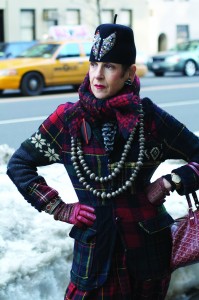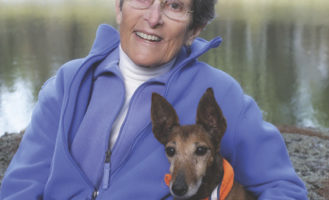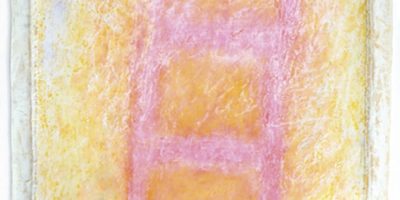Tziporah Salamon & the Art of Getting Dressed
Tziporah Salamon, on her bright-colored Italian bicycle, always wearing extraordinary outfits, turns heads wherever in Manhattan she rides. Lucky for me, my friend Jolie Mansky invited me to one of Salamon’s private two-hour sessions on “The Art of Dressing.” Before I went, I googled Salamon and discovered that she’s regularly photographed by Bill Cunningham for his renowned “On the Street” columns for The New York Times, has performed her one-woman show at the Rubin Gallery of Art, is one of the stars of last winter’s Lanvin couture ads (catch her on YouTube), and was just spotlighted in Ari Seth Cohen’s new book Advanced Style.
I’d never encountered anyone who took such pains with every tiny choice involved in putting together each ensemble she donned that evening in her “class.” While six or eight women watched raptly, she created multi-layered outfits out of vintage pieces or custom-made elements, each accessorized with painstaking precision. One pillbox hat is not like another, it turns out.
Salamon, 60, was born in Netanya, Israel, and at nine moved to the U.S. with her Holocaust-survivor parents, he a tailor and she a seamstress. Always obsessed with fabrics and fashion, Salamon went off to do graduate work in psychology in Berkeley. But even as an activist in the nascent days of the women’s liberation movement, she said, she was reading Vogue hidden behind Ms. magazine!
She starts each performance of her personal style announcing that an honest look in the mirror “to know your own body” is the way getting dressed must start. Her own basic garments are pants that are a kind of mid-calf pantaloon and a snug-fitting jersey. The pants—loose at the calf because she decided her lower legs are now too muscular from bike riding to be on display—she has copied in different colors from a couture pair she bought years ago. And then the fun really begins. With a rack of vintage items and bargain designer finds (and a student intern from a local fashion high school to help her hang and fold as she goes along), Salamon layers on the looks. One outfit consists of a shirt, sweater with pom-pom buttons, jacket also with pom-poms (she threads them through alternate buttonholes for full effect) topped with a short white fur capelet. Then come the earrings, scarf, and perfect cloche-like hat. “I love the pierrot look,” she said.
The paradox is that Tziporah Salamon is authentically terrific at what she does, though her unusual, even outré style choices would on almost anyone else simply be dismissed as eccentric. Truth is, on anyone else, this getup would indeed look clownish. But the devotion to the details is redemptive. Salamon’s mantra: “I am a painter. My body is my canvas.” Sometimes, she said, it takes her a decade or more to decide that an outfit is completed according to her demanding standards of artistic perfection. She scouts thrift shops, vintage clothing fairs, and the legendary Brimfield marketplace in Massachusetts for the perfect pocketbook, or even the perfect pom-pom to complete an outfit.
Her life is decidedly non-luxurious; she lives in a modest Manhattan apartment, often paying for her vintage indulgences in monthly installments. She works as a part-time teacher, gives her classes in private homes and at conferences, and though trained as a psychologist, she says her highest paying job was one she worked for years—as a hat-check person (we once would have said girl) in a fancy New York restaurant; she got huge tips from patrons excited to see what she was wearing. In a stint as a salesperson at Bergdorf Goodman, she was told not to outshine the clientele.
You can see Tziporah Salamon in context—and in assorted extraordinary outfits—at tziporahsalamon.com. She attributes her appreciation for the legitimacy of her clothes consciousness to an encounter with Reb Zalman Schachter-Shalomi, who told her that she brings radiance into the word by dressing so beautifully. Radiance may be the result, but what are the motivating forces behind her really quite thrilling efforts to be so constantly and consciously on display? “My parents were Holocaust survivors, and they let me know that the idea was to keep down, not call attention to yourself,” she said, making a “keep down” motion with both hands. “But now,” she announced, raising her arms high, “I am out there.”





